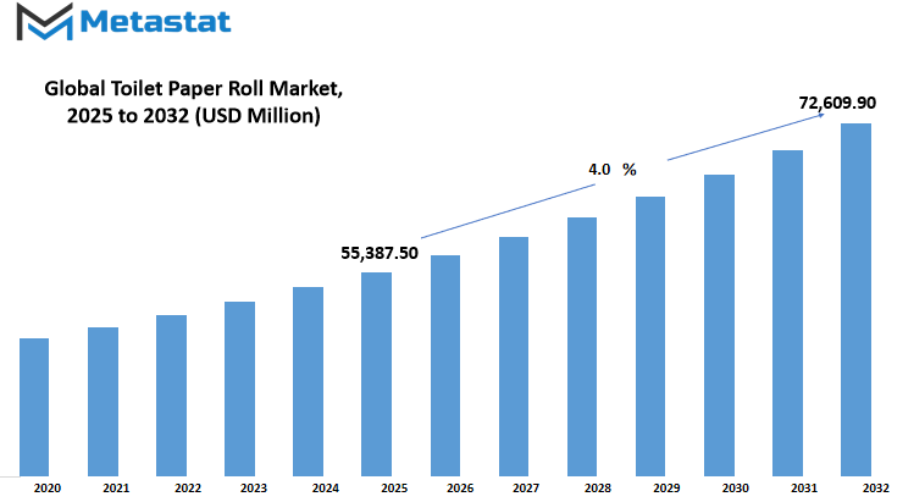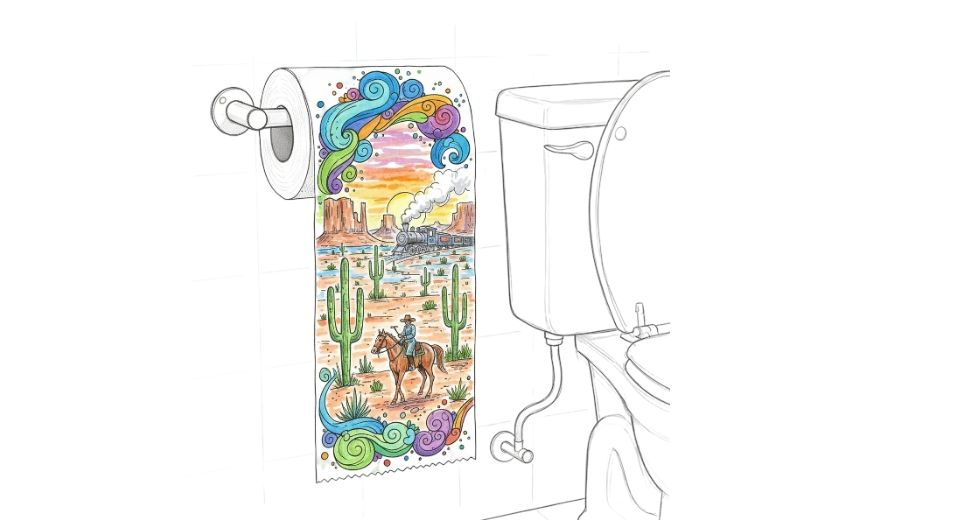MARKET OVERVIEW
The global toilet paper roll market will stretch much further than a mere mundane function of hygiene, developing into a sector that will drive cultural behavior, sustainability objectives, and even manufacturing technology. Though it might seem to be a daily need with little room for modification, this sector will go on to redefine itself into areas that will surprise consumers and producers alike. The toilet paper roll, which was once viewed as a mundane household item, will become increasingly a topic of international discussion, where issues of quality, sourcing, and disposal will drive companies to position themselves.
The future market will not only be one that caters to household demand but also one that looks for innovations that will combine functionality with environmentally friendly practices. Consumers will demand products that reflect their values, and industry will adjust with materials that both minimize the impact on the environment while maintaining comfort. The global toilet paper roll market will not remain limited to its conventional application; it will become increasingly a vehicle whereby companies will project their dedications to health, convenience, and responsibility. Paper softness, paper strength, paper quality, and roll length will become competitive attributes, setting the stage for ongoing innovation that will fuel consumer demand.
A second level of growth will result from the social and cultural impact of toilet paper rolls globally. Nations will tailor the market to preferred tastes that will extend beyond thickness or scent. Markets will focus on value in some, while others will be focused on high-end experiences. This divergence will result in a heterogeneous range of demand that producers will have to strike a balance between. As the global toilet paper roll market expands further, the debate on access will become more profound too, so that fundamental hygiene standards will be fulfilled everywhere, regardless of where or how they are situated economically.
The digital space will play an unexpected role in shaping consumer habits within this industry. Online retail will offer visibility to products that were once only confined to local stores. Marketing strategies will highlight not just comfort but also innovation in packaging, storage efficiency, and recycling benefits. In this way, the industry will transform from a product-driven segment into an experience-driven one, where consumers will purchase based on trust, reputation, and sustainability credentials.
Apart from functionality, the toilet paper roll will be incorporated in the discourse around responsible waste management worldwide. The global toilet paper roll market will be used as a model of how an everyday product can drive big-picture conversations around responsible production. Businesses will invest in reducing water and chemicals consumption when making paper, and the contribution of biodegradable materials will gain prominence. These innovations will place the industry not only as a household goods provider but as a player in global environmental advancement.
In the future, the global toilet paper roll market will display that even the most mundane products can power innovation. By expanding its territory to sustainability, cultural relevance, and technological advancement, the industry will solidify its role as each a commodity and a marker of modern living.
Global toilet paper roll market is estimated to reach $72,609.90 Million by 2032; growing at a CAGR of 4.0% from 2025 to 2032.

GROWTH FACTORS
The global toilet paper roll market has emerged as a significant segment of the overall hygiene business, driven mostly by growing sensitivity to sanitation habits. In developed and developing markets alike, the utilization of toilet paper is no longer perceived as a luxury but as an elementary need attached to cleanliness and individual welfare. This increasing consciousness has not only driven higher consumption at the household level but has also stretched to schools, offices, hospitals, and public places, rendering toilet paper one of the most widely consumed hygiene items globally.
Both the hospitality and commerce industries also contribute significantly to driving demand. Restaurants, hotels, airports, and malls require a steady bulk supply because upholding hygiene levels directly affects customer satisfaction and service levels. Worldwide travel and tourism expansion also contributes to this demand, as corporations in these industries perceive hygiene as an indicator of professionalism. Having a consistent requirement guarantees a stable consumer market, making it possible for the market to grow even beyond consumer household.
Though crucial, the global toilet paper roll market is met with challenges that will require proper focus in the future. Among the urgent issues is the environmental concern associated with deforestation and mass waste production. Manufacturing traditional lavatory paper relies significantly on pulp, and raw cloth charge fluctuations pressure up the value of manufacture for companies. Growing concerns for sustainability are making governments, organizations, and purchasers undertaking long-time period strategies, exerting strain on producers to seek alternatives that motive less harm to the environment.
Amidst all of the demanding situations, opportunities are also arising. Green and recycled toilet paper is on the rise, fueled by consumer choice and regulatory compulsion towards cleaner methods. Several companies are starting to innovate in this direction, bringing forth products that do not compromise on quality but decrease environmental impacts. Soon, these substitutes will define the course of the market, promising growth by solving some of its most fundamental issues.
MARKET SEGMENTATION
By Product Type
The global toilet paper roll market will remain among the best-selling household items in both the developed and developing world. What seems a mundane commodity in reality is a mirror to trends in lifestyle, cleanliness consciousness, and purchasing behavior globally. With evolving lifestyles, population increases, and urbanization, demand for toilet paper rolls will continue to grow steadily, making a market that is evolving not just on the basis of volume but also on product variety and quality.
Of the major categories, segmentation by product type provides a significant dimension to this market. The scented toilet paper category alone has been worth $7,727.36 million, indicating the increasing interest among consumers in convenience and premium hygiene products. This suggests that people are not handiest purchasing lavatory paper as a utilitarian product however also as a product associated with non-public grooming. Conversely, the unscented category will still persist as the greater universally regular choice due to its lower value, greater accessibility, and purchaser desire for a greater neutral variation. Overall, these categories illustrate a stability between luxurious-based totally call for and everyday purposeful use.
The perfume section will enchant homes that feel extra freshness and enjoyment, commonly focused on upscale shoppers within the metropolitan marketplace. This phase can also be aided by using progressive packaging and branding subject matters emphasizing life-style attraction. Conversely, the unscented phase will experience constant call for across rural and metropolitan markets, regularly added in bulk and focused on households and establishments that fee price for money. The expansion of these two product categories illustrates how the marketplace responds to diverse degrees of consumer aspirations, starting from affordability to luxurious.
In the future, the global toilet paper roll market will continue to be linked to the fluctuation in disposable profits, retail availability, and customer behaviors inspired by way of present day residing requirements. While the perfumed segment will continue growing at greater margins, the unperfumed segment will dominate as the solid, reliable option. Both segments combined indicate that rolls of toilet paper are not simply commodities but products driven by lifestyle choice, culture, and economics. This combination of need and desire will make the market active and ensure persistent demand globally.
By Material Type
The global toilet paper roll market has become a daily commodity in homes, commercial establishments, and public amenities. Although it might seem like an easy product, toilet paper rolls have undergone huge transformations over the years with manufacturers continuously trying to weigh comfort, durability, and sustainability. Consumer demand is at the forefront of dictating the industry, as consumers become more conscious of hygiene levels and the environmental profile of the products used. This has challenged manufacturers to reconsider materials and manufacturing processes in an effort to produce products that not only satisfy consumers' expectations but also encompass general environmental awareness.
Demarketing by material type, the industry is segmented into non-biodegradable and biodegradable toilet paper rolls. Non-biodegradable rolls have lengthy maintained a dominant position due to their popularity, affordability, and ability to supply softness and sturdiness that customers crave. The developing environmental focus approximately waste control and pollution is, however, slowly nudging clients closer to biodegradable merchandise. These environmentally friendly rolls decompose with no trouble, curbing the load on landfills and proving to be an attractive choice for green consumers.
Demand for biodegradable bathroom paper rolls will probably continue to grow as governments, agencies, and groups more and more promote greater environmentally pleasant alternatives. Sustainable packaging and waste control efforts are driving the demand, and biodegradable rolls have come to be a customer- and producer-pleasant lengthy-term solution. Even though these objects often value greater than their non-biodegradable loved ones, most purchasers can pay extra for merchandise that reflects their values and helps cease the destruction of the surroundings.
While so, non-biodegradable rolls will nonetheless cater to the bulk of the market because of their fee affordability and ubiquity, especially in regions wherein focus and infrastructure for environmentally friendly alternatives are nevertheless in their formative stages. This price-sustainability balance will determine the competitive forces working in the marketplace within the coming years. Manufacturers will focus on achieving the top-of-the-line stability of overall performance, value, and eco-friendliness to stay within the race in an industry that has such a direct impact on everyday life globally.
By Application
global toilet paper roll market will continue to be defined by its end use applications, with household and commercial usage being the two key segments. Household use is a huge share, with toilet paper being a daily requirement in both urban and rural households. Growing awareness of hygiene, rising disposable incomes, and growing population will drive household demand over the years. In most areas, particularly in developing nations, more households are moving from conventional practices to packaged toilet paper rolls, which will contribute to market growth. This daily dependency assures that the domestic application is constant and less susceptible to volatility, so it is a main driver of long-term stability.
Conversely, the commercial segment will be instrumental in influencing patterns of demand. Offices, hotels, schools, hospitals, and public facilities all need toilet paper rolls in bulk. Growth in the service industry and hospitality sector will generate greater demand in this segment. With rapid urbanization and tourism growth in countries, commercial use of toilet paper will see greater usage, particularly with greater focus on sanitation levels. They usually buy in bulk, and commercial buyers therefore generate a considerable amount of revenue for the market.
Household and business applications, while different, will continue to be related in terms of how they drive manufacturing and availability. Most manufacturers customize packaging, size, and strength by material for each use. For domestic use, softness and comfort tend to be priorities, whereas for business, bulk packaging and toughness are the priorities. This distinction indicates the ways in which uses determine not just buying trends but also how producers approach satisfying different consumers.
Looking forward, both segments will remain significant contributors, with domestic use providing day-to-day consistency and commercial demand powering large-scale growth prospects. Both, collectively, are the foundation of the global toilet paper roll market, guiding its path in terms of manufacturing, distribution, and innovation. Through supporting both individual and institutional requirements, the market itself will be robust and responsive to future changes in consumer trends and industrial demand.
By Distribution Channel
global toilet paper roll market is influenced by how people decide to purchase necessary goods in their daily lives. As hygiene and household needs are constant, the mode of accessing toilet paper rolls has broken the monolithic way of buying. Contemporary shopping decisions show a combination of affordability, convenience, and choice of diverse retail formats. This has given rise to various distribution channels, each with their own benefits, that will continue to have an impact on how the market evolves in the coming years.
Retail websites have become widely popular as online shopping becomes mainstream. The comfort of being able to order bulk lavatory paper rolls, installation regular deliveries, and revel in aggressive pricing makes the channel popular among many families. Online stores also enable manufacturers to give greater products than brick-and-mortar shops, facilitating easier comparison of satisfactory, packaging, and charge earlier than a consumer makes a decision. The ease of doorstep delivery, particularly for bulk packs, will keep to make on-line shops a favored desire for increasingly more customers.
Hypermarkets and supermarkets continue to be a strong distribution channel because they give consumers the opportunity to combine toilet paper purchases with their routine grocery buying. Consumers appreciate the opportunity to handle packages sizes, softness of tissues, and reputation of the brands before making a purchase. Incentives and savings offered in these big-box retail outlets further invite bulk buying. The presence of various brands in one place enables healthy competition, which keeps influencing consumer choice and market share in this category.
Convenience stores are also influential, especially for impulse buying and for buyers who need smaller packaging. Their presence in both urban and semi-urban areas guarantee consistent sales, although the price may be a tad higher than in large retail stores. In addition to these, other channels of distribution like wholesale suppliers and specialty stores contribute to the market's coverage by reaching niche markets and institutional buyers. All of them make toilet paper rolls widely available, responding to varied shopping patterns.
As the behavior of consumers changes with the adoption of digital, changes in lifestyle, and heightened urbanization, the distribution channel mix will keep growing. Online channels will become increasingly popular, yet offline shops will continue to be relevant because of their existing customer base and factor of trust. This equilibrium between online and offline channels reflects the way the global toilet paper roll market will balance meeting consumer expectations while ensuring convenience through various buying options.
|
Forecast Period |
2025-2032 |
|
Market Size in 2025 |
$55,387.50 million |
|
Market Size by 2032 |
$72,609.90 Million |
|
Growth Rate from 2025 to 2032 |
4.0% |
|
Base Year |
2024 |
|
Regions Covered |
North America, Europe, Asia-Pacific Green, South America, Middle East & Africa |
REGIONAL ANALYSIS
The global toilet paper roll market demonstrates regional variation based on lifestyle, economic conditions, and cultural trend. In North America, the U.S. dominates demand owing to its high population and strong consumer demand for premium-quality hygiene products. Canada and Mexico also contribute significantly, with Canada more inclined towards sustainability-focused choices and Mexico experiencing increasing demand thanks to urbanization and improved standard of living. Combined, this region remains well-established in that homes and institutions increasingly use toilet paper as a day-to-day necessity.
The consumer mentality for quality and environmentally friendly products drives the market to a significant extent in Europe. The UK, Germany, France, and Italy have moved to incorporate recycled and sustainably produced toilet paper, which represents the increasing concern for environmental issues. The Rest of Europe also has similar trends with consistent demand connected to private consumption and public establishments. The region will continue to be a major contributor owing to the established market and consumer affinity for brand and ecologically friendly goods.
The Asia-Pacific region has some of the fastest emerging opportunities in the Toilet Paper Roll market. With India and China, among others, undergoing rapid urbanization, demand is growing as lifestyles evolve and awareness of hygiene increases. Japan and South Korea, however, demonstrate solid and steady demand, with choices frequently favoring high-quality and soft texture. The Rest of Asia-Pacific remains promising as emerging economies embrace new hygiene customs, positioning this group among the most dynamic in influencing the market's future.
South America is slowly seeing more robust adoption, spearheaded by Brazil and Argentina, where urbanization and increasing disposable incomes are fueling greater consumption. Even though the region has its challenges in uneven distribution and price sensitivity, the demand will increase as awareness and availability increase. Likewise, the Middle East & Africa region offers varied patterns of growth. GCC nations, with their advanced infrastructure and increased spending capacity, are inclined towards premium toilet paper products, while South Africa and Egypt exhibit robust demand in both mid-range and economy segments. The Rest of the region still exhibits stable growth as sanitation awareness increases and retail networks expand.
Collectively, the global toilet paper roll market indicates how regional tastes and economic prosperity influence demand differently throughout the globe. While developed markets such as North America and Europe focus on quality and sustainability, developing regions of Asia-Pacific, South America, and the Middle East & Africa will fuel future growth as hygiene levels increase and buying power improves. This combination of consistent consumption in mature economies and growing demand in emerging ones ensures the toilet paper sector will always be an essential component of worldwide consumer requirements.

COMPETITIVE PLAYERS
The global toilet paper roll market has continued to expand into one of the most necessary domestic and business segments, driven by daily need and shifting consumer lifestyles. Something once viewed as a straightforward commodity is now a competitive market that mirrors consumer demand for quality, softness, sustainability, and price. As awareness on cleanliness and hygiene increases, toilet paper rolls have become a necessity in families, offices, restaurants, and public areas in both developed and developing countries. Since demand will continue growing in the future years, the market will not only portray utility but also innovation in product development and green manufacturing.
The market is dominated by a few dominant companies, which have entrenched themselves as family names with good brand recognition and distribution channels. Kimberly-Clark Corporation, with its century-long history, remains pivotal, and Procter & Gamble Co., under its Charmin label, has made a major contribution towards influencing consumer choice. As for these, the market players such as Essity Hygiene and Health AB, Georgia-Pacific LLC, and Cascades Tissue Group are impactful worldwide manufacturers having a large variety of toilet paper products designed for different markets. Their future strategies will remain trendsetters in the industry, weighing between affordability and quality while adjusting to increased demand for eco-friendly options.
One distinct feature of this market is its diversity, with players from various areas competing at regional and global levels. Sofidel Group, Kruger Inc., Wepa Hygieneprodukte GmbH, and Vinda International Holdings Limited have significant shares, whereas Fujian Hengan Group Co., Ltd. and First Quality Enterprises, Inc. play roles in increasing supply through sophisticated methods of manufacture. Metsä Group under the brand name of Kartin has focused on environmentally friendly tissue solutions, whereas Paperwings India LLP and Lotus Tissue Papers Products are contributing immensely to the Asian market. Their participation reflects the way the market is not just influenced by multinational companies but also local manufacturers concentrating on localized requirements.
Sustainability is emerging as a major path for most of these participants because consumers are becoming more aware of the environmental impact of paper manufacturing. Firms such as Seventh Generation and Softer Paper Co. have established themselves on the path of using recycled content and green business practices. Concurrently, companies like Sinar Mas Paper (China) Investment Co., Ltd., C&S Company Limited, and Softly Global are tapping the need for premium tissue products in emerging economies. This combination of international powerhouses and local innovators generates a market that will grow not only in size but also in diversity, providing consumers not only convenience but also choices that fit their values.
In the future, the global toilet paper roll market will expand as demand increases and competition increases. From high-end items made for softness and comfort to economy rolls made for cost, the variety of products will mirror the requirements of a large base of consumers. Important players will reinforce their positions based on innovation in manufacturing, emphasis on recycled and biodegradable materials, and optimal global supply chains. As more people and institutions appreciate the role of cleanliness, the toilet paper roll will continue to be an essential product, with both international brands and new regional producers maintaining the market.
Toilet Paper Roll Market Key Segments:
By Product Type
- Scented
- Unscented
By Material Type
- Biodegradable
- Non-Biodegradable
By Application
- Household
- Commercial
By Distribution Channel
- Online Stores
- Supermarkets/Hypermarkets
- Convenience Stores
- Others
Key Global Toilet Paper Roll Industry Players
- Kimberly-Clark Corporation
- Procter & Gamble Co. (Charmin)
- Essity Hygiene and Health AB
- Georgia-Pacific LLC
- Cascades Tissue Group
- Sofidel Group
- Kruger Inc.
- Wepa Hygieneprodukte GmbH
- Vinda International Holdings Limited
- Fujian Hengan Group Co., Ltd.
- First Quality Enterprises, Inc.
- Metsä Group (Kartin)
- Paperwings India LLP
- Lotus Tissue Papers Products
- Seventh Generation
- C&S Company Limited
- Softly Global
- Softer Paper Co.
- Sinar Mas Paper (China) Investment Co., Ltd.
WHAT REPORT PROVIDES
- Full in-depth analysis of the parent Industry
- Important changes in market and its dynamics
- Segmentation details of the market
- Former, on-going, and projected market analysis in terms of volume and value
- Assessment of niche industry developments
- Market share analysis
- Key strategies of major players
- Emerging segments and regional growth potential








 US: +1 3023308252
US: +1 3023308252






